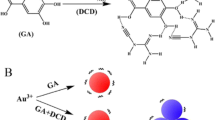Summary
The dicyanogen split off from organic compounds can be detected by reaction with 8-hydroxyquinoline and alkali cyanide. Since oxamide yields dicyanogen on gentle warming with phosphorus pentoxide, and guanidine (guanidine salts) as well as melamine and guanamine produce dicyanogen on pyrolysis, specific or selective tests for these compounds have been based on this behavior.
Salts of guanidine and its derivatives containing the
group, can be detected selectively through the fact that they yield ammonia when heated to 220–250°.
Diguanidine and its derivatives give no ammonia when pyrolyzed. All these tests can be conducted as spot tests. Attention is called to interferences due to compounds which split off dicyanogen or ammonia when heated.
Zusammenfassung
Aus organischen Verbindungen abgespaltenes Dicyan ist durch die Rotfärbung bei Umsetzung mit 8-Oxychinolin und Alkalicyanid nachweisbar. Da Oxamid bei gelinder Erwärmung mit Phosphorpentoxyd und Guanidin (Guanidinsalzen) sowie Melamin und Guanamin bei ihrer Pyrolyse Dicyan abspalten, so läßt sich darauf ein spezifischer bzw. selektiver Nachweis der genannten Verbindungen begründen. Salze des Guanidins und dessen Derivate mit einer freien
-Gruppe sind selektiv nachweisbar durch den Nachweis des bei ihrer Pyrolyse abgespaltenen Ammoniaks. Diguanidin und seine Derivate geben bei der Pyrolyse kein Ammoniak ab. Sämtliche Nachweise sind in der Arbeitsweise der Tüpfelanalyse ausführbar. Auf die störende Wirkung von Substanzen, die Dicyan oder Ammoniak beim Erhitzen abgeben, wird hingewiesen.
Résumé
Le dégagement de dicyanogène résultant de la dégradation de composés organiques peut être détecté par la 8 hydroxyquinoléine et un cyanure alcalin. Il résulte de ce fait que l'on a pu mettre au point des tests spécifiques ou sélectifs pour l'oxamide qui, par chauffage doux en présence d'anhydride phosphorique donne naissance à du dicyanogène, ainsi que pour la guanidine (sels de guanidine), la melamine et la triazine symétrique dont la pyrolyse produit également du dicyanogène.
Les sels de guanidine et de ses dérivés contenant le groupement
peuvent être détectés sélectivement par le dégagement d'ammoniac qui se produit lorsqu'on les chauffe à 220–250°.
La pyrolyse de la biguanidine et de ses dérivés ne produit pas d'ammoniac. Tous ces tests peuvent être effectués sous forme d'essais à la touche. On attire l'attention sur les perturbations apportées par les composés qui donnent naissance à du dicyanogène ou de l'ammoniac par chauffage.
Similar content being viewed by others
References
F. Feigl andL. Hainberger, Analyst, in press.
A. S. Komarowsky andW. S. Poluektoff, Z. analyt. Chem.96, 23 (1934).
G. Kainz andA. Resch, Mikrochem.39, 75 (1952);G. Kainz andF. Schöller, Mikrochim. Acta [Wien]1954, 327.
E. Ott, Ber. dtsch. chem. Ges.52, 663 (1919); compare alsoTh. Wallis, Ann. Chem.345, 362 (1906).
A. Sievert andA. Hermsdorf, Z. angew. Chem.34, 3 (1921); compare alsoF. Feigl, Spot Tests. 4th ed. Vol. I. New York: Elsevier. 1954. p. 258.
H. Krall, J. Chem. Soc. London107, 1399 (1915).
A. Smolka andA. Friedreich, Mh. Chem.10, 91 (1889).
F. Feigl andW. A. Mannheimer, Mikrochem.40, 50 (1953).
E. Bamberger andW. Dieckmann, Ber. dtsch. chem. Ges.25, 543 (1892).
E. Drechsel, J. prakt. Chem. [2]13, 331 (1876).
P. Karrer, Organic Chemistry, 4th English ed. New York: Elsevier. 1950. pp. 286, 287.
Author information
Authors and Affiliations
Rights and permissions
About this article
Cite this article
Feigl, F., Neto, C.C. Detection of oxamide, guanidine, and guanidine derivatives in spot test analysis. Mikrochim Acta 43, 969–978 (1955). https://doi.org/10.1007/BF01223992
Received:
Issue Date:
DOI: https://doi.org/10.1007/BF01223992




